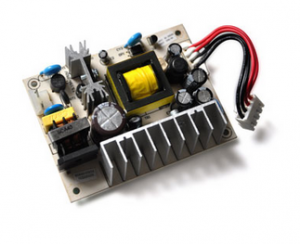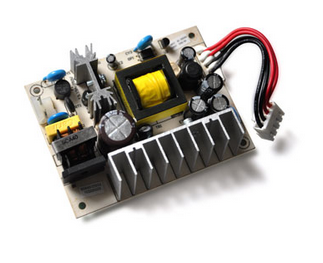How many do you know about LED driver power?
â– Input voltage range
When the user sees that the input voltage range marked on the power supply is 85-265VAC and the actual use is 100-240VAC, in fact, the so-called tightening ±10% test (IEC60950 tightening +6%-10%) will be carried out during the safety certification, so the voltage range defined in the power supply specification will not be problematic in use; The mark on the power supply is to meet the safety specifications and ensure that the user can correctly input the power supply.
â– Power factor (PFC)
PowerFactorCorrection (PFC) Power factor correction to improve the ratio between the effective power and the apparent power at the input end of the power supply. Generally, models without PFC lines have a power factor of only 0.4 to 0.6 at the input end, while active PFC lines can reach more than 0.95, and the correlation formula is as follows:
Apparent power = input voltage x input current (VA)
Effective power = Input voltage x input current x power factor (W)
From the point of view of environmental protection: the power plant of the power company must produce more than the apparent power of electric energy, its generator set can stabilize the supply of electricity demand in the market, and the actual use of electric energy is the effective power. If the power factor is 0.5, it means that the generator set emits more than 2VA of electricity in order to safely supply the demand of 1W of electric energy, and its energy operation efficiency is poor. On the contrary, if the power factor is improved to 0.95, then as long as the generator set of the power company emits more than 1.06VA of electricity, there is no problem in supplying 1W of electricity demand, and the energy operation efficiency is better.
â– Protection function
Over-voltage/over-current/overload/over-temperature fault protection refers to the protection action that occurs when the power supply is activated when the power supply cannot work normally due to changes in internal and external conditions such as the input power supply, load, environment, cooling circuit or device failure, which threatens the safety of the power supply.
OVP: OverVoltageProtection. A feature of a switching power supply circuit that protects the switching power supply and load from abnormally high voltages at the output.
Undervoltage protection: When the power supply voltage of the protected line is lower than a certain value, the protector cuts off the line; When the power supply voltage returns to the normal range, the protector is automatically switched on.
OCP: OverCurrentProtection. In the DC switching power supply circuit, in order to protect the adjusting tube from being burned when the circuit is short circuit and the current is increased. The basic method is that when the output current exceeds a certain value, the adjustment tube is in a reverse bias state, so as to cut off the circuit current automatically.
ShortCircuitProtection: Limits the output current of the switching power supply to a safe value during a short circuit to protect the switching power supply from damage.
OTP: overheating protection circuit (OverTemperatureProtection. The high integration and light weight and small size of the switching regulator in the DC switching power supply greatly improve the power density per unit volume, so if the components of the power supply device have no corresponding increase in the requirements of their working environment temperature, it will inevitably deteriorate the circuit performance and prematurely fail the components. Therefore, the overheat protection circuit should be set up in the high-power DC switching power supply.
There are several ways to protect (action) :
1. Restart (Disconnect the power supply and then switch it on again. Automatic and manual);
2. hiccup (intermittent output);
Foldbacklimiting (a method that linearly reduces the output current to normal when the load is close to a short circuit); 3.
4. Current limiting (Constantcurrentlim or constant current, which can limit the output current from infinite growth due to overload or short circuit of the load. Even if the load is short-circuited, it will not cause equipment downtime and power damage).
5. Shutdown Overcurrent/overload/overvoltage/overtemperature fault usually refers to the dangerous state when the output current/power/(or input) voltage and radiator temperature exceed the protection threshold of the rated value of the power supply.
â– Surge current
The switched power supply will have a short period of time (1/2~1 power cycle, EX: 60Hz power supply 1/120~1/60 second) of the large current (according to the product design is about 20~60A, please refer to the product specification), the product will be returned to normal current input after startup, each time in the power input moment will appear, this is a normal phenomenon, will not cause damage to the power supply. However, it is not recommended to continuously turn the power supply on/off. In addition, it should be noted that if multiple power supplies are turned on at the same time, it may cause the protection switch of the system distribution to trip, it is recommended that multiple power supplies delay the start, or use the remote control function of the power product to delay the sequential start of the product.
â– Output voltage accuracy
Output voltage accuracy refers to the difference between the actual output voltage and the rated output voltage, and this error is the superposition value of line stability and load stability. Usually this parameter is +/-1% Line stability refers to the percentage of the output voltage that deviates from the rated voltage when the input voltage varies between the maximum and minimum values of the allowed range. Load stability refers to the percentage of the output voltage that deviates from the rated voltage when the output load current varies between the maximum and minimum of the allowed range.
Why use constant current power supply to drive LED lamps?
LED life refers to the time of light decay, constant current drive because of the control of the LED current, to ensure that the LED chip junction temperature is not too high, to prevent the semiconductor chip, packaging materials, fluorescent materials abnormal aging. The luminous intensity of the LED will not be reduced too quickly (that is, light decay). The use of other types of power supply can not control the LED current constant, because its temperature rise is not easy to control, resulting in the occurrence of light decay.
The luminous intensity of the LED is proportional to the size of the current, therefore, the LED driver power needs to have a constant current output characteristic to ensure that the LED can obtain a stable luminous intensity during use and the long life guaranteed by the manufacturer. Constant current power supply In order to ensure that the constant current drives the LED, the LED must be in series to ensure that the current of each LED in the circuit is equal and constant. When the power demand of the LED lamp group is increasing, the number of LED series is increasing, the voltage demand is proportional to the number of series, the resulting voltage is getting higher and higher, the safety is easy to cause problems, the manufacturing and use requirements will be more stringent, which will bring the cost of power and the use of difficulties. Therefore, the drive of high-power LED has the requirement of low-voltage drive.
CV+CC power supply can work at constant voltage, can also work at constant current.
â– IP level

IPXY dustproof and waterproof rating
Dust class (X)
Waterproof rating (Y)
0. There is no protection
1. Prevent large solid intrusion (>50mm)
2. Prevent intrusion of medium sized solids (>12mm)
3. Prevent small solids from entering (>2.5mm)
4. Prevent solids larger than 1mm from entering
5. Prevent harmful dust accumulation
6. Completely prevent dust from entering
0. There is no protection
1. Water drops into the shell have no effect
2. When the shell is tilted to 15 degrees, the water drop on the shell has no effect
3. Water or rain from 60 degrees corner to the shell has no effect
4. Liquid poured into the shell from any direction has no harmful effect
5. Rinse with water without any harm (12.5l/min)
6. Rinse with a large water column without any harm (100 l/min)
7. Can be soaked in a short time (30 minutes, 1 meter away from the water)
8. Immersed in water for a long time under a certain pressure, the test time and conditions are defined by the manufacturer and the buyer.
*IP64-IP66 grade models, suitable for indoor humid environment or outdoor places with rain shelter, the actual installation related restrictions, please refer to the IP grade test definition
* Models above IP64 grade, suitable for indoor wet or outdoor occasions.
*IP67 products cannot be placed in water for long periods of time
Efficiency: The ratio of total output power to active input power expressed as a percentage. That is, efficiency = output power/input power *100%.
Rated power: refers to the maximum output power of the power supply (voltage V and current A product).
EMC: Electromagnetic Compatibility (EMC) is the ability of a device or system to operate in its electromagnetic environment in compliance with requirements and not to cause intolerable electromagnetic interference to any equipment in its environment. EMC includes EMI (Electromagnetic interference) and EMS(electromagnetic tolerance) two departments, the so-called EMI electromagnetic interference, for the switch power conduction or radiation of harmful energy. EMS refers to the ability of the switching power supply to perform its intended function without being affected by the surrounding electromagnetic environment.
Ripple: Since the DC stable power supply is generally formed by the AC power supply through the rectification and voltage regulation and other links, it is inevitable that there are some AC components in the DC stable quantity, and the AC component superimposed on the DC stable quantity is called ripple.
RippleandNoise,Output: The amplitude of the AC voltage output by a switching power supply over a specified bandwidth, usually expressed as a peak-peak value or RMS value of the millivolt class.
Total harmonic distortion: TotalHarmonic distortion, referred to as THD. Refers to the additional harmonic part of the output signal (harmonics and their frequency doubling components) more than the input signal when the signal source is input, usually expressed as a percentage. Generally speaking, the total harmonic distortion at 1000Hz frequency is the smallest, so many products use the distortion of this frequency as its indicator. Therefore, when testing the total harmonic distortion, the sound of 1000Hz is emitted to detect, and the smaller the value, the better.
Overshoot and Undershoot: Overshoot is when the first peak or valley exceeds the set voltage – the highest voltage for rising edges and the lowest voltage for falling edges. A downsurge is the next valley or peak. Excessive overshoot can cause the protective diode to work, leading to premature failure. Excessive downrushes can cause false clock or data errors.
Working environment Temperature, Temperature OperatingAmbient: switching power supply can reasonable electrical indicators and stability of the working Temperature range. Unless specified so, do not think that the switching power supply can output full power over the entire temperature range, nor does it mean that the switching power supply can maintain the same electrical indicators over the entire operating temperature range.
PWM: PluseWidthModulation: A method of voltage regulation used in switching power supplies in which the output is controlled only by changing the width of the pulse train.

